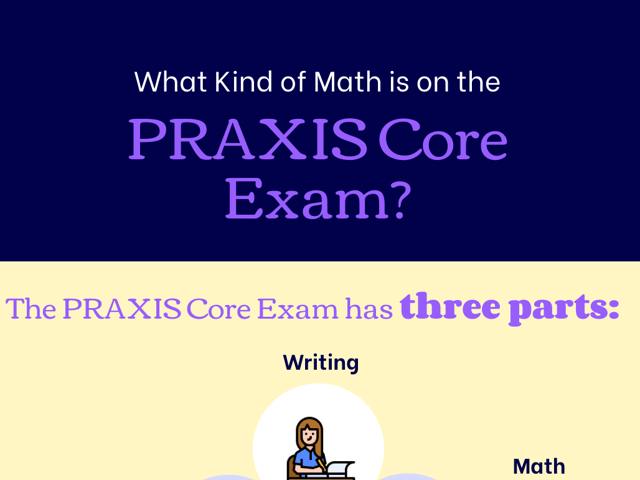
What Kind of Math is on the PRAXIS Core Exam?
The PRAXIS Core Exam has three parts: reading, math, and writing. The math test comprises 56 questions to be answered in 90 minutes. There are three main categories of questions on the test and there are three types of questions.
Recent Changes
Since September 2019, the PRAXIS Core Mathematics test has gone through some reconstruction. This has been done to reflect the actual needs of being a teacher, rather than focusing more on more advanced math concepts. The changes are:
-
Fewer questions on algebra and geometry—Previously, about 50% of the test consisted of algebra and geometry questions. Now, these subject areas make up only 32% of the test.
-
More emphasis is now placed on data Interpretation, statistics, and probability.
-
A geometry formula sheet has been introduced. The significance of word problems has been stressed more. You have to understand a word problem and solve it using multiple steps.
-
The following topics have been eliminated:
- Radical equations
- Functions
- Rational and irrational numbers
- 3D geometry
Types of Questions
-
Selected Response—These questions expect you to select one choice (the correct answer) from a list of five answer choices.
-
Multiple Choice/Multiple Response—These questions ask you to select one or more choices from a list of choices.
-
Grid-Ins/Numeric Entry—These questions ask you to answer with a decimal, integer, or fraction that you enter into a set of boxes or a “grid”.
This is a computer-administered test during which you can use the four-function on-screen calculator to aid with simple arithmetic.
Concepts Covered on the Test
There are three main concept areas tested on the exam:
1. Number and Quantity
About 36% of the test is composed of questions on the concepts of number and quantity. In order to ace this part, you need to have a thorough understanding of operations with integers and fractions, percents and decimals, properties of whole numbers, ratio and proportional relationships, and rate problems. If you have a sound understanding of these concepts, you will be good to go.
2. Algebra and Geometry
About 32% of the test is on this topic. More specifically, algebra is assessed by 20% of the questions and geometry is 12% of the questions.
You have to know basic algebraic properties, equivalent expression, evaluating expressions, solving linear and quadratic equations, and be able to apply these in all sorts of algebraic word problems.
For geometry, you have to be well versed in the basic shapes and their properties, angles and their properties, congruence and similarity, and areas and volumes of circles.
3. Data Interpretation and Representation, Statistics, and Probability
32% of the new PRAXIS Core Mathematics test involves this topic. Knowing your graphs (line graph, bar graph, and circle graph) will be a huge advantage. Understand measures of central tendency (mean, median, and mode, measures of spread, range, standard deviation, and scatterplot relationships). A firm understanding of basic probability theory is required to be able to attempt and correctly answer all questions of this section.
The PRAXIS Core Mathematics test isn’t that tough if you prepare for it strategically. Taking Praxis practice tests, reading study guides, and using flashcards will help you understand (and not just memorize) the core mathematics concepts you need to know. Read the instructions carefully and understand the question clearly, and everything will be fine!

Keep Reading

PRAXIS Test Blog
How Long Should I Study for the Praxis?
Do you have a passion for teaching? Teachers play a central role in gui…

PRAXIS Test Blog
Number and Quantity Formulas for the PRAXIS® Core Academic Skills for Educators Mathematics Test
The “PRAXIS Core Academic Skills for Educator: Mathematics” Test (5733)…

PRAXIS Test Blog
Data, Statistics, and Probability Formulas for the PRAXIS® Core Academic Skills for Educators Mathematics Test
The importance of Data, Statistics, and Probability for the “PRAXIS Cor…